When the streets are busy, it can be difficult to stay safe behind the wheel. In such situations, many people are tired or impatient, rushing to get from point A to point B. That’s why we have traffic laws—to ensure that drivers share the road responsibly and everyone moves in an orderly and predictable way.
As outlined in Section 21800 of the California Vehicle Code (CVC), there are circumstances where a driver must yield to other drivers on the road. Ignoring these regulations can result in a failure-to-yield ticket.
The penalties include a substantial fine and one point on your driving record. Things are even worse for drivers who cause accidents because they did not yield the right of way.
Curious about CVC 21800 or failure-to-yield violations in California? And what to do once you’ve gotten a failure-to-yield ticket? Here’s what you should know about it.
What is a CVC 21800 Failure to Yield?
Failure to yield is a traffic offense that occurs when a driver doesn’t give the right of way to other vehicles, pedestrians, or cyclists. California Vehicle Code Sections 21800-21809 describe all the situations in which it’s required to yield to another driver.
In 2022, nearly 7% of all fatal crashes that took place on U.S. roads were due to failure to yield right of way, per the National Safety Council (NSC). This was the third most common cause of deadly accidents, after speeding and careless driving.

Failure-to-yield accidents often occur at intersections or when changing lanes, which makes them particularly dangerous. If just one driver breaks the rules, his behavior can cause multiple collisions.
Let’s say you don’t yield the right of way when switching lanes. This can result in a sideswipe collision with a vehicle already in that lane. The crash could create a chain reaction, as other cars will try to avoid the collision (which may not be possible).
This traffic offense won’t always result in a car crash, but it could add a point to your license. If it does lead to an accident and you’re found at fault, you may face civil penalties or even jail time.
Traffic school can help you keep a clean driving record, prevent insurance increases, and more!
Scenarios Covered by CVC 21800
California drivers must yield the right of way when approaching an intersection or four-way stop, as well as in other traffic situations, such as when the traffic lights go out.
With that in mind, let’s take a closer look at the different scenarios covered by Vehicle Code Sections 21800-21809.
1. CVC 21800 (a)
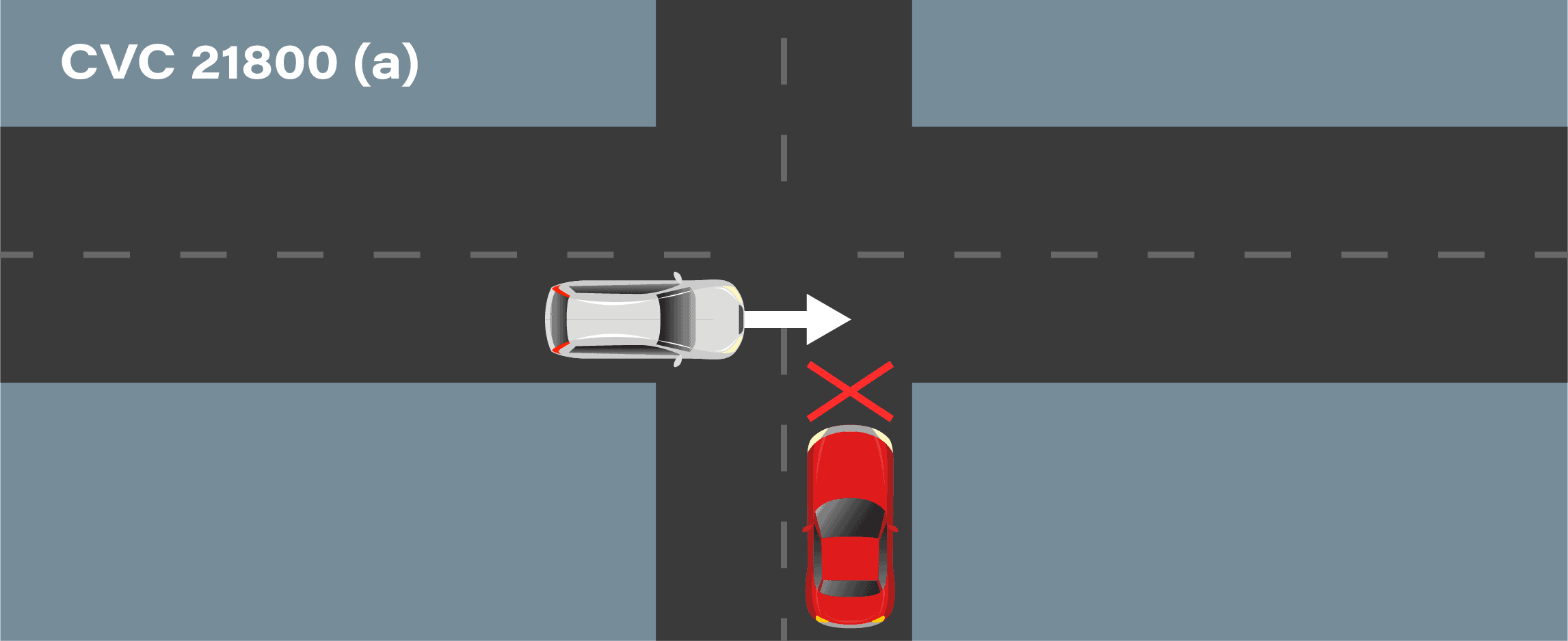
CVC 21800 (a) requires drivers approaching an intersection to yield to motorists that have already entered the intersection.
“The driver of a vehicle approaching an intersection shall yield the right-of-way to any vehicle which has entered the intersection from a different highway.”
Imagine you’re driving on a quiet street and approaching a four-way intersection without any stop signs or traffic signals. As you get closer, you notice a car has already entered the intersection.
According to CVC 21800 (a), you should stop and wait for the other vehicle to clear the intersection before going any further. Otherwise, you could collide with it and be held responsible for the accident.
2. CVC 21800 (b)(1)
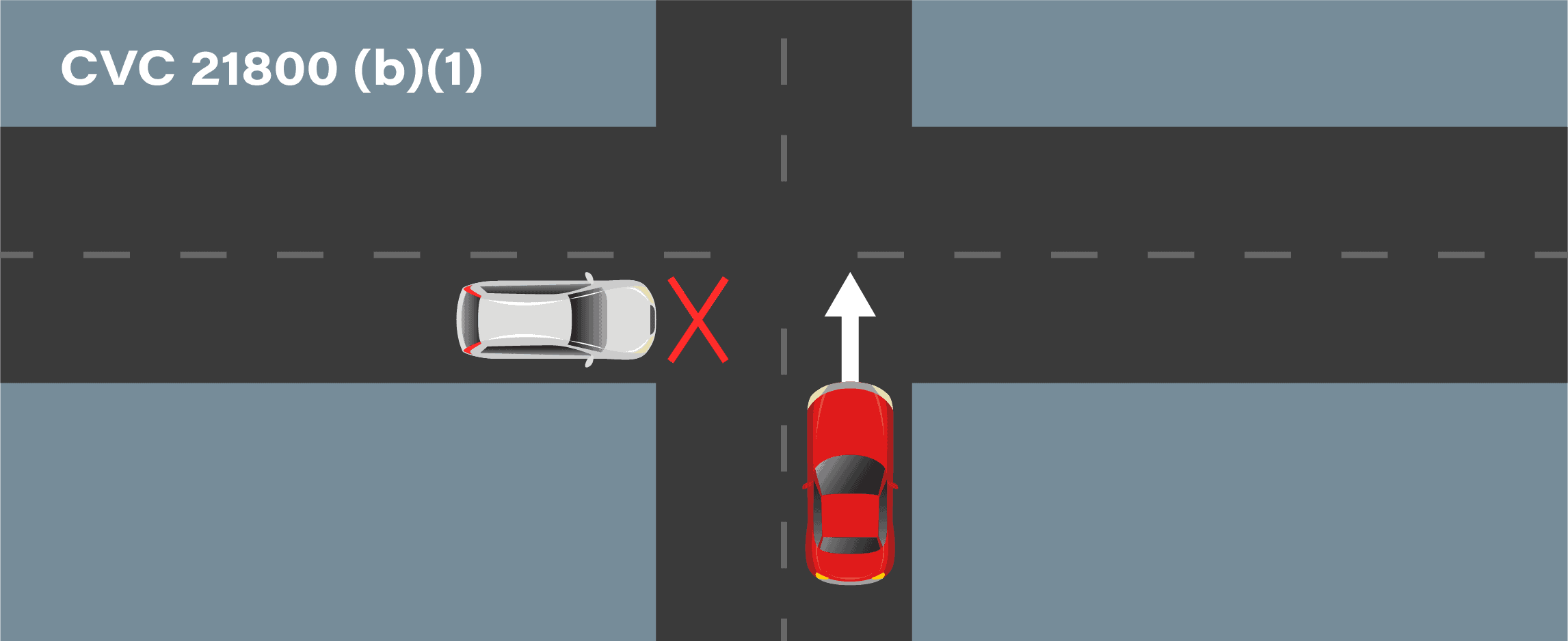
CVC 21800 (b)(1) states that if two vehicles arrive at an intersection at the same time, the driver on the left must yield to the driver on the right.
“When two vehicles enter an intersection from different highways at the same time, the driver of the vehicle on the left shall yield the right-of-way to the vehicle on his or her immediate right, except that the driver of any vehicle on a terminating highway shall yield the right-of-way to any vehicle on the intersecting continuing highway.”
Let’s assume you arrive at an intersection at the same time as a vehicle coming from your right.
What you should do is allow the other driver to go through the intersection first. Failure to yield could result in a T-bone accident where the front of your vehicle would hit the side of the other car.
3. CVC 21800 (c)
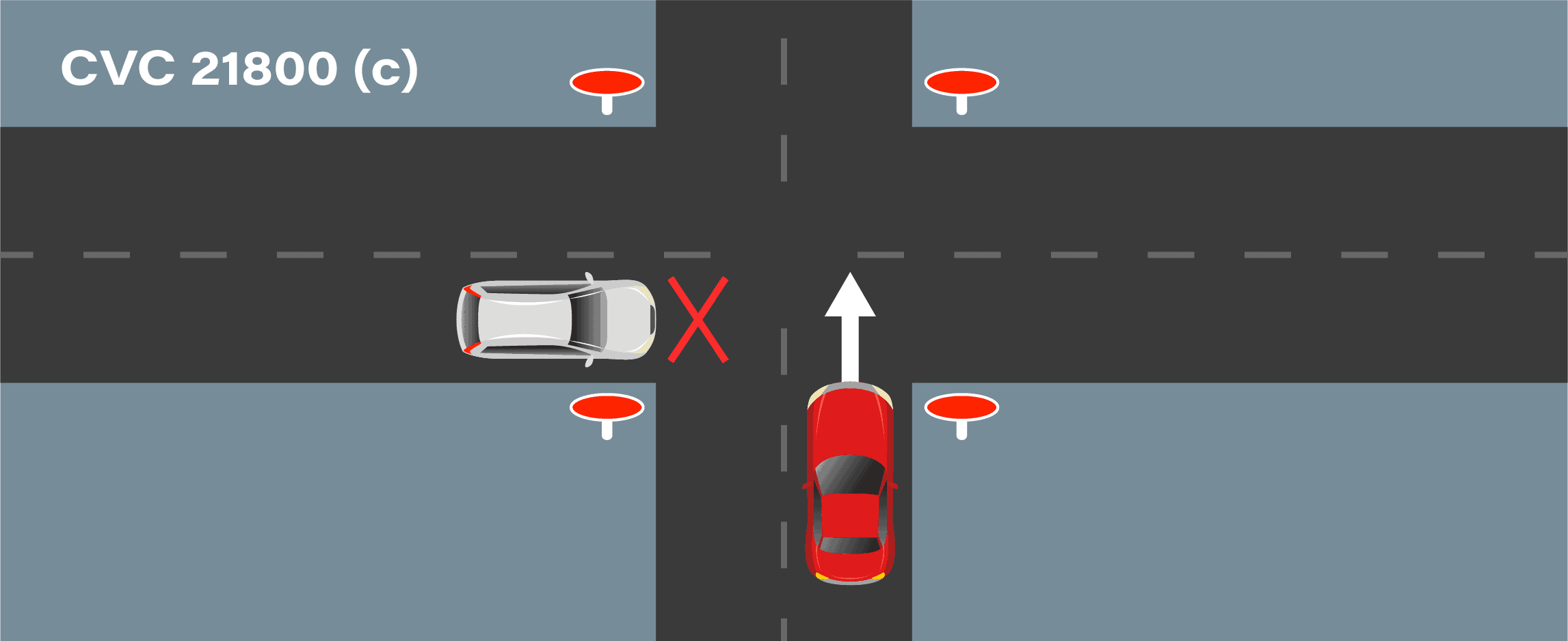
CVC 21800 (c) is very similar to CVC 21800 (b)(1), except it specifies that if two vehicles arrive at an intersection at the same time that is controlled in all directions by stop signs, the driver on the left must yield to the driver on the right.
“When two vehicles enter an intersection from different highways at the same time and the intersection is controlled from all directions by stop signs, the driver of the vehicle on the left shall yield the right-of-way to the vehicle on his or her immediate right.”
Returning to the previous example, imagine you’re entering an intersection with all directions controlled by stop signs. Let any vehicles on the right go through, and then continue your journey.
Read: California Road Signs and Their Meanings
4. CVC 21800 (d)(1)
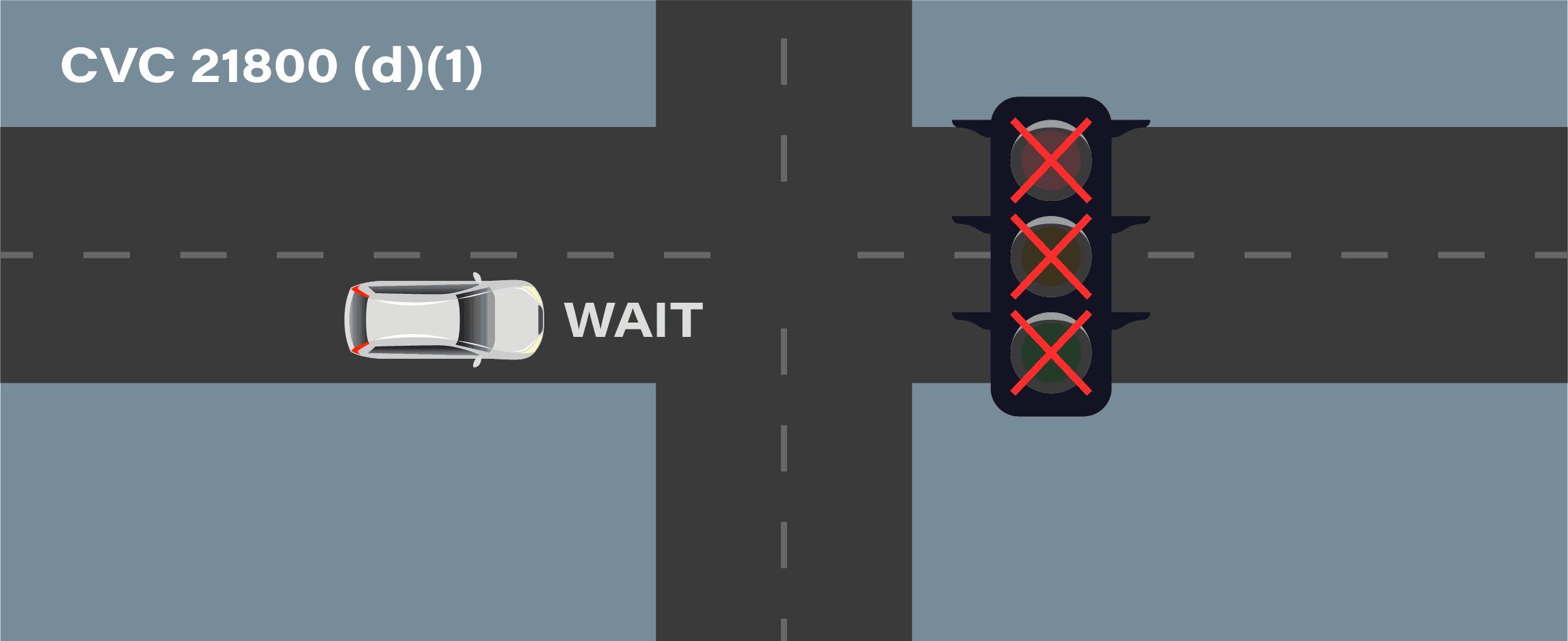
CVC 21800 (d)(1) states that when a driver arrives at an intersection with a traffic signal that isn’t working, that driver must stop, and only proceed into the intersection when it is safe to do so.
“The driver of any vehicle approaching an intersection which has official traffic control signals that are inoperative shall stop at the intersection, and may proceed with caution when it is safe to do so.”
Now let’s say you’re driving on a busy road. At some point, you arrive at an intersection where the traffic lights are off due to a power outage.
In such situations, you must come to a complete stop. Take a good look in all directions, checking for other vehicles, pedestrians, cyclists, and road hazards. Wait until it’s safe to continue through the intersection.
5. CVC 21800 (d)(2)
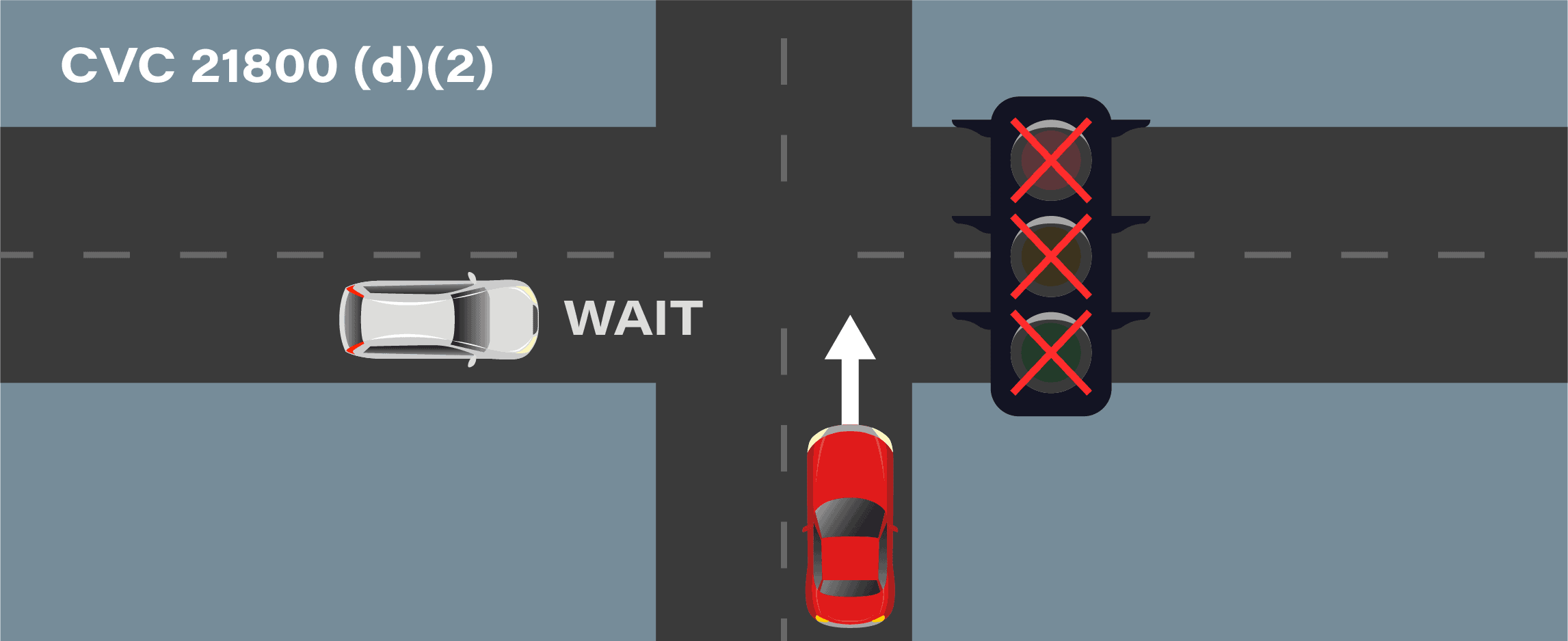
CVC 21800 (d)(2) is similar to the above, stating that when two drivers arrive at the same time to an intersection with a traffic signal that isn’t working, both must come to a complete stop, and the driver on the left must yield to the driver on the right.
“When two vehicles enter an intersection from different highways at the same time, and the official traffic control signals for the intersection are inoperative, the driver of the vehicle on the left shall yield the right-of-way to the vehicle on his or her immediate right, except that the driver of any vehicle on a terminating highway shall yield the right-of-way to any vehicle on the intersecting continuing highway.”
6. CVC 21801
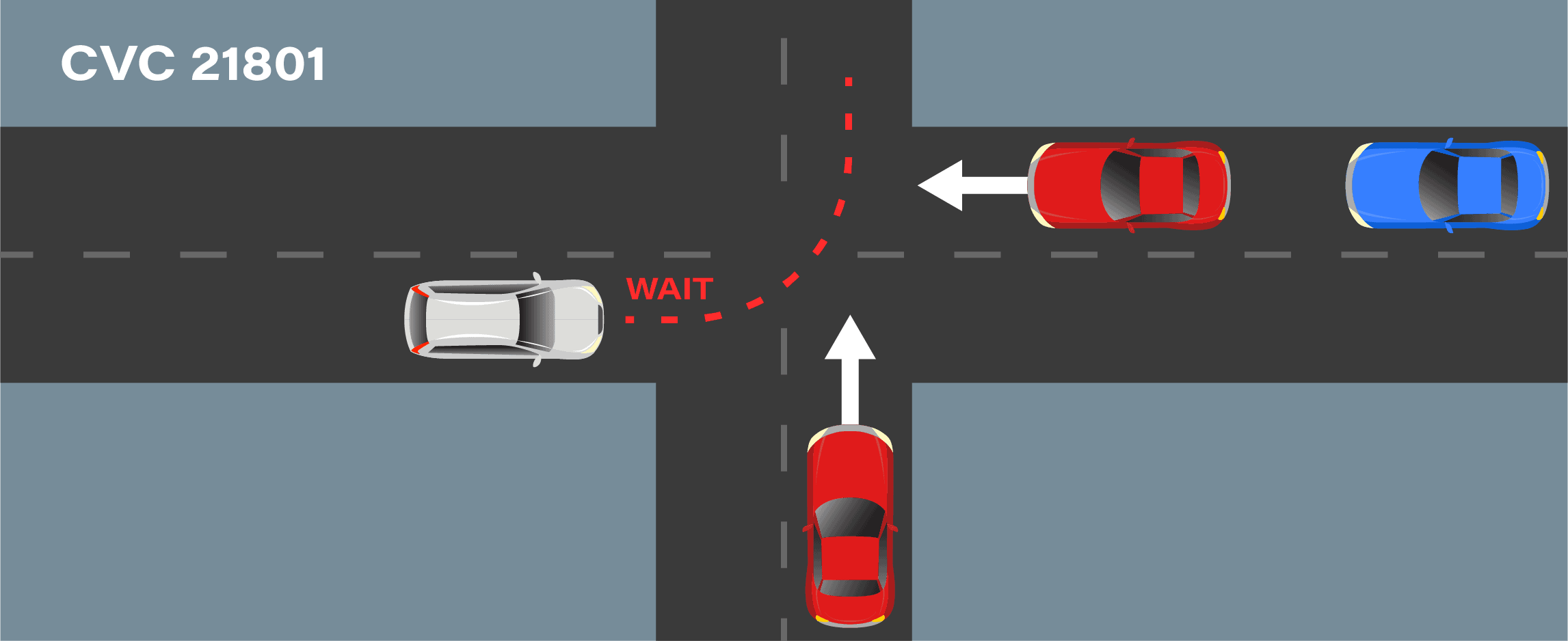
CVC 21801 states that drivers making any leftward maneuver that requires them to cross other lanes of traffic may only do so after yielding to all vehicles approaching from the opposite direction.
“The driver of a vehicle intending to turn to the left or to complete a U-turn upon a highway, or to turn left into public or private property, or an alley, shall yield the right-of-way to all vehicles approaching from the opposite direction which are close enough to constitute a hazard at any time during the turning movement, and shall continue to yield the right-of-way to the approaching vehicles until the left turn or U-turn can be made with reasonable safety.”
Imagine you’re driving in the first lane and must cross three lanes of traffic to get to a car wash on the left side of the road.
To stay safe, move to the second lane from the right ahead of time. Then yield the right of way to the vehicles approaching from the opposite direction.
Wait until the road is clear or until another driver lets you pass.
7. CVC 21802
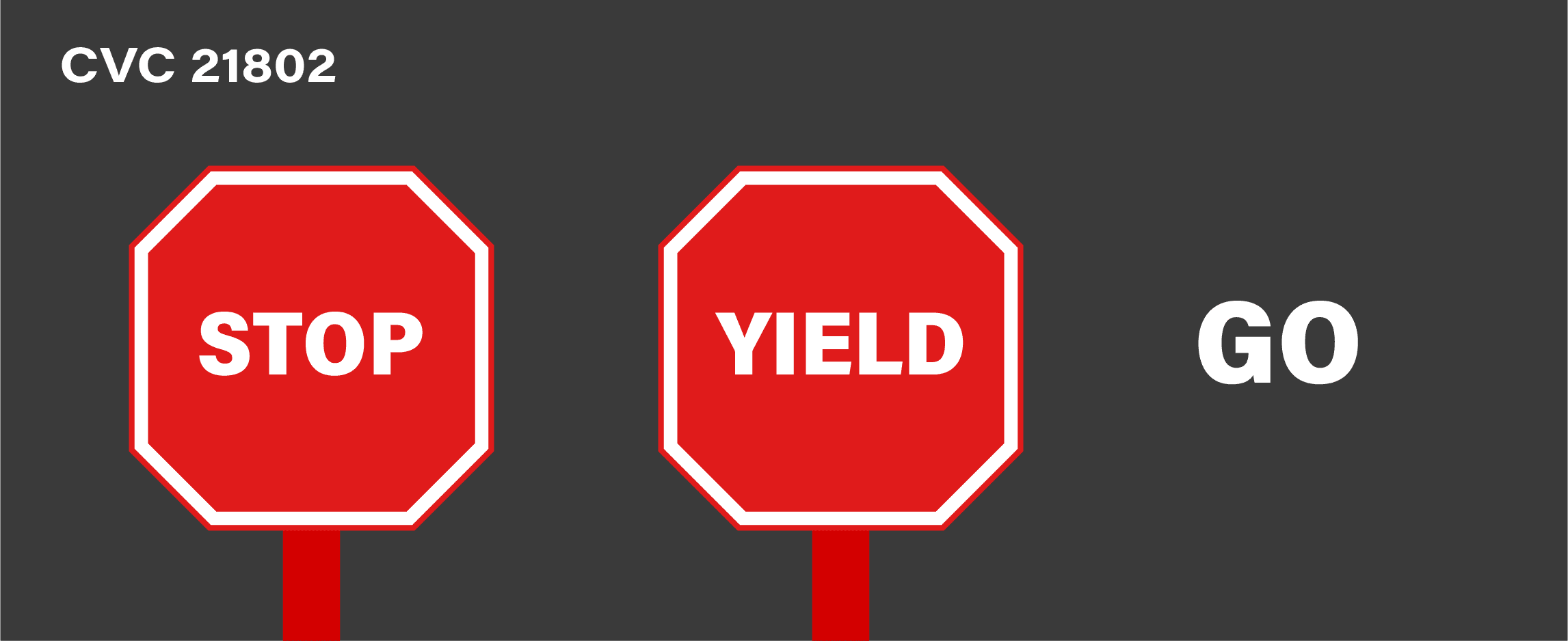
Section 21802 of the California Vehicle Code comprises three rules that apply at intersections with stop signs:
- The driver must stop at the stop sign;
- Then yield to any drivers who have already reached the intersection;
- Proceed through the intersection after yielding.
“The driver of any vehicle approaching a stop sign at the entrance to, or within, an intersection shall stop as required by Section 22450. The driver shall then yield the right-of-way to any vehicles which have approached from another highway, or which are approaching so closely as to constitute an immediate hazard, and shall continue to yield the right-of-way to those vehicles until he or she can proceed with reasonable safety.”
8. CVC 21803
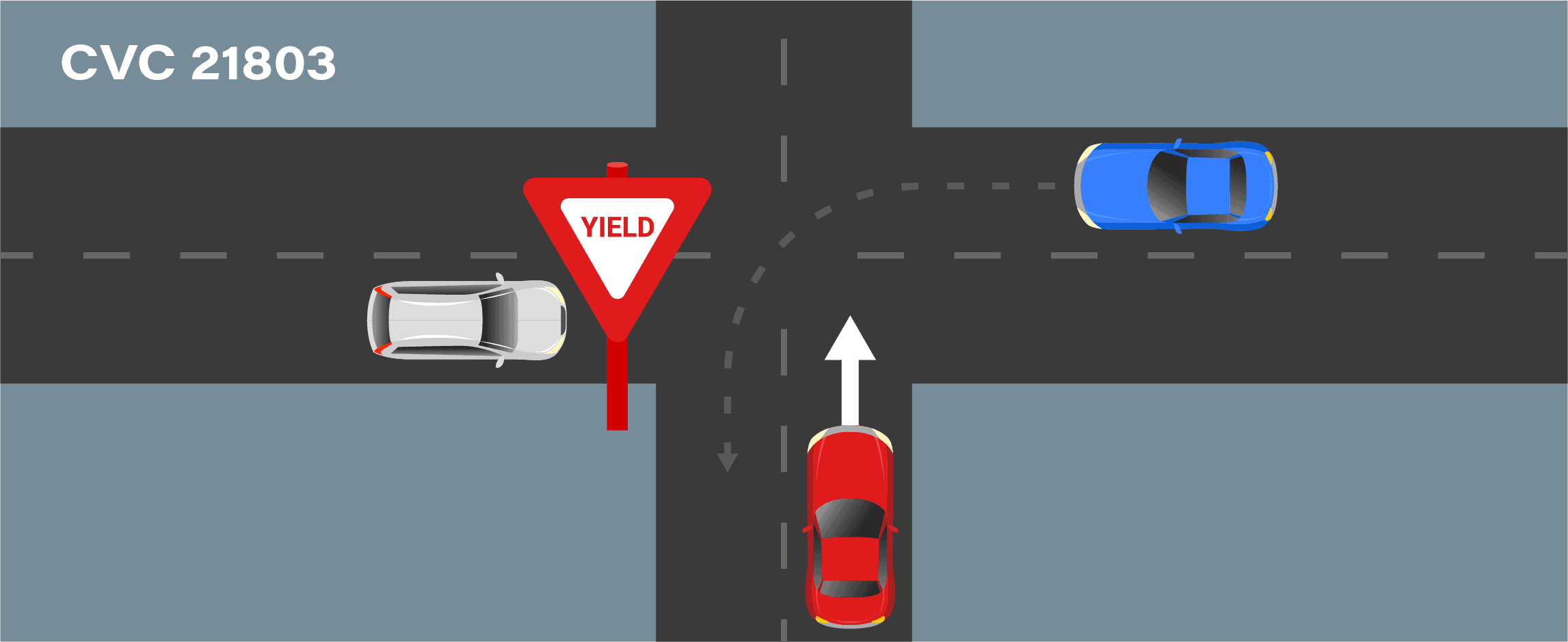
CVC 21803 states that drivers approaching an intersection with a yield sign must yield to other vehicles in the intersection.
“The driver of any vehicle approaching any intersection which is controlled by a yield right-of-way sign shall, upon arriving at the sign, yield the right-of-way to any vehicles which have entered the intersection, or which are approaching on the intersecting highway close enough to constitute an immediate hazard, and shall continue to yield the right-of-way to those vehicles until he or she can proceed with reasonable safety.”
9. CVC 21804
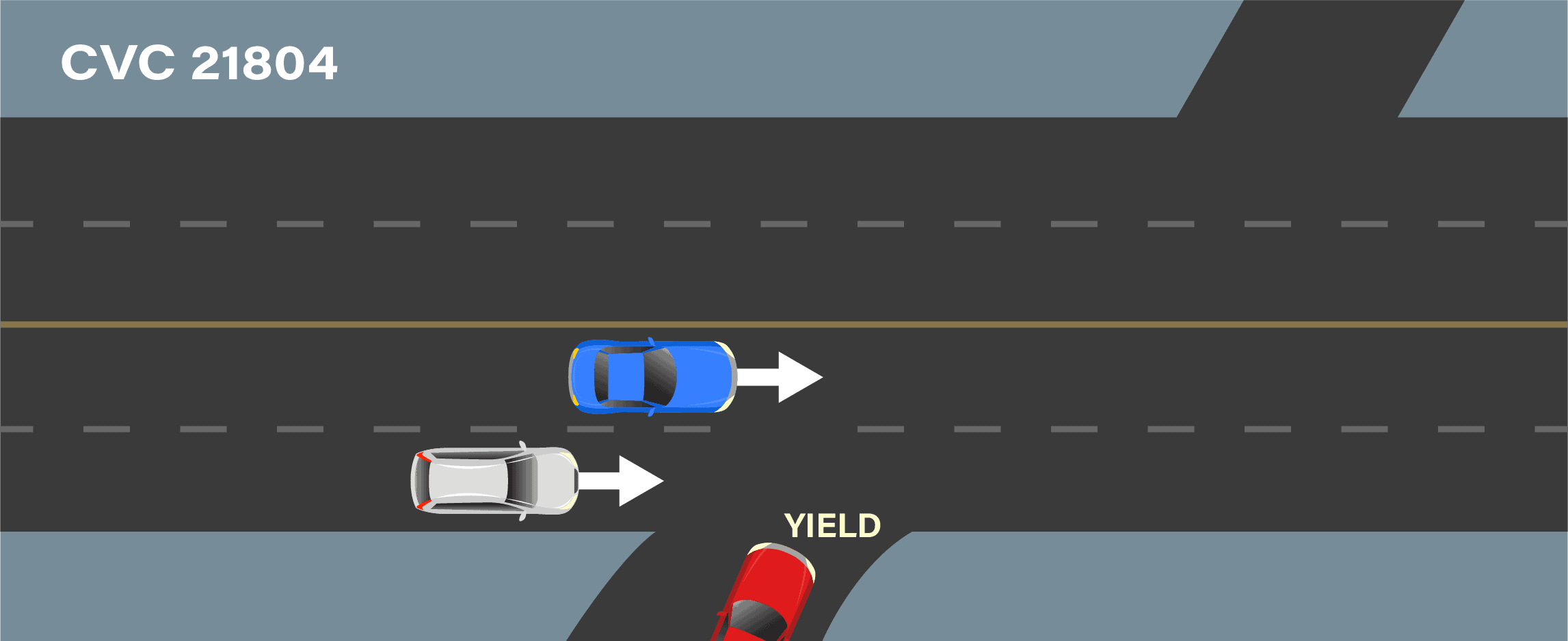
CVC 21804 states that any driver entering or crossing a highway must yield to all traffic on the highway approaching from either direction.
“The driver of any vehicle about to enter or cross a highway from any public or private property, or from an alley, shall yield the right-of-way to all traffic, as defined in Section 620, approaching on the highway close enough to constitute an immediate hazard, and shall continue to yield the right-of-way to that traffic until he or she can proceed with reasonable safety.”
Imagine you’re driving out of a gas station and need to turn right on a highway. Before entering the road, you must yield to all vehicles that are close enough to pose a risk.
Wait until you’re 100% sure you can pull out onto the highway. If you misjudge the speed of an approaching vehicle and hit the road without yielding, the other driver may slam on their brakes or swerve to avoid a collision.
10. CVC 21805

CVC 21805 applies to equestrian crossings or bridle paths marked with appropriate signs at highway intersections. Drivers crossing these areas must yield the right of way to any horseback rider on the highway.
“The driver of any vehicle shall yield the right-of-way to any horseback rider who is crossing the highway at any designated equestrian crossing, which is marked by signs as prescribed in subdivision.”
Yielding to Emergency Vehicles
Sections 21806, 21807, and 21809 relate to authorized emergency vehicles, such as police cars, ambulances, fire trucks, and more.
California drivers are required to yield the right-of-way to emergency vehicles using sirens and flashing lights at the time of operation. They must also move out of their way, pull to the right, and stop until the vehicle has passed.
Yielding to Pedestrians
There are also a couple of rules on yielding to pedestrians, but those fall under CVC 21950.
What you should know is that pedestrians have the right of way on crosswalks, as well as at intersections without crosswalks. In either case, drivers must slow down or come to a full stop until the pedestrian is out of the way.
Consequences of Violating CVC 21800
Failure to yield can be fatal, especially when combined with speeding or distracted driving. It can also take a toll on your wallet, resulting in hefty fines and higher insurance rates.
This infraction carries a fine of $238, plus administrative and court fees, which can vary based on where you received the ticket. Additionally, you’ll get one point on your license—and the points add up over time. (This aligns with the cost of most speeding tickets in California.)

Under the California DMV’s Negligent Operator System (NOTS), getting multiple points on your record within a set period can lead to harsher penalties, such as having your driver’s license suspended or revoked.
Having even one point on your license may also cause your auto insurance premiums to go up. Meaning that the true cost of a CVC 21800 ticket can run into thousands of dollars.
And, as mentioned earlier, failure-to-yield accidents may lead to imprisonment. Plus, the victims may request compensatory damages for pain and suffering, disfigurement, income loss, and more.
How to Handle a CVC 21800 Citation
The right way to handle a failure-to-yield citation depends on your circumstances. You could go to traffic school, seek legal representation, or contest the ticket without appearing in court.
Here’s what you should know about each of these options.
1. Seek Legal Help for a Failure-to-Yield Ticket
If you believe that the citation was issued in error or that the consequences of a conviction could be significant, it may be worth seeing an attorney. They can provide you with legal advice and represent you in court, which may increase your chances of winning the case and having the citation reduced or dismissed.
The same goes if your failure to yield resulted in property damage, bodily injury, or someone’s death.
For example, Dugas Law Firm has taken on the case of a woman whose husband died in a failure-to-yield accident.
The crash was caused by a truck driver, and the victim’s wife filed a lawsuit against him for:
- Negligent driving
- Failure to break on time
- Not yielding the right of way
The driver was held liable for the accident and had to pay compensation, including the victim’s medical bills, funeral costs, and other expenses.
In such cases, it’s in your best interest to hire an attorney. They’ll gather evidence, interview witnesses, and negotiate with the prosecutor to reduce charges.
However, if the citation is for a minor infraction—and you get away with a ticket, you may be able to handle things on your own. For instance, you could participate in a trial by written declaration or attend a court hearing.
All in all, whether you should hire a traffic lawyer for a CVC 21800 (or any traffic ticket) depends on your specific situation. Consider your driving history, the consequences of your actions, and the charges you’re facing. You can learn more in How Much Does a Traffic Lawyer Cost? (And When to Hire One.)
2. Write a Trial by Written Declaration for a Failure to Yield
A trial by written declaration is a legal process in California that allows individuals to contest a traffic citation without appearing in court. Instead, individuals have the option to submit a written declaration explaining why they believe they didn’t commit the violation they were cited for.

To write a trial by written declaration for a failure to yield violation in California, you should follow these steps:
- Obtain the proper form: You can obtain a Trial by Written Declaration form from the court where the citation was issued or from the California DMV website.
- Fill out the form: Provide your personal information and include a brief statement explaining why you believe the citation was issued in error. You may also include any relevant evidence, such as photographs or witness statements.
- Submit the form: Submit the form, along with any supporting evidence, to the court by the due date indicated on the citation.
- Wait for a decision: The court will review your written declaration and make a decision based on the information you have provided. If you win, no further action is necessary. If you lose, you have the option to schedule a court hearing to present your case in person.
3. Go to Traffic School for a Failure-to-Yield Ticket
Depending on your situation, you may be allowed to attend traffic school for a failure-to-yield ticket in California. Completing this step can mask one point on your driving record, hiding it from insurance companies. As a result, it can prevent your insurance rates from increasing.
In the Golden State, drivers can complete traffic school once every 18 months—but they must request permission from the court to attend.
If the court approves your request, you can save time and money by attending online.
Best Online Traffic School offers a DMV-licensed course that’s fast, convenient, and affordable. You can complete it in your own time, on your own devices—and you don’t have to pay until you pass.
Ready to mask your failure-to-yield violation? Start traffic school online today for free.
